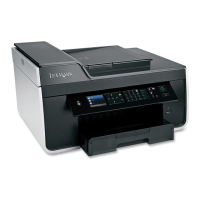Information you will need during advanced wireless setup
The Wireless Setup Utility does not detect the wireless network SSID for you during advanced wireless setup. You
must know the following information before configuring the wireless printer settings manually:
Wireless Mode
Check your wireless network type:
Infrastructure—All devices on a wireless network communicate with each other through an access point
(wireless router).
Ad‑Hoc—Network devices communicate directly with each other without the use of centralized security or
access point. Ad hoc mode may be available in select models or operating systems only.
Note: Infrastructure is the recommended network configuration because of its faster transfer speeds, better security
options, and ease of configuration.
Network Name (SSID)
This is the identifying name that distinguishes a network from other networks in the area.
Channel
Auto is selected by default and cannot be changed if the network is configured in infrastructure mode.
Notes:
• Ad hoc mode may be available in select models or operating systems only.
• If the network is set up in ad hoc mode, then select the channel that other devices in the network are using.
All devices in an ad hoc network must use the same channel to communicate with each other.
• The printer can communicate on only one wireless network at a time. Configuring the printer for an ad hoc
wireless network will keep it from working on any other wireless network, either ad hoc or infrastructure.
Authentication
Determine if you have an infrastructure or ad hoc setup, and then check the corresponding authentication type.
Note: Some authentication types may be available in select models or operating systems only.
Wireless mode Authentication type
Infrastructure
• Open Mode
• Shared Mode
• WPA Personal
• WPA2‑Personal
• WPA2‑Enterprise
• 802.1X ‑ RADIUS
Ad hoc Open Mode
Encryption
Check the encryption method used on your network.
Note: Some authentication types may be available in select models or operating systems only.
Networking
100

